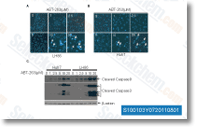Due to the fact label absolutely free proteomics evaluation revealed that MEK1 two ERK1 2 signal to down regulate 36 phos phopeptides in SS RBCs, it was essential to establish the pathophysiological relevance on the abundance of those phosphopeptides by initial displaying that their levels had been down regulated in AA RBCs when compared with SS RBCs. Comparison of individual phosphopeptide inten sities among SS and AA RBCs indicates that out of those 36 phosphorylated peptides in SS RBCs, the abun dance of only 25 of these phosphopeptides have been inhibitor MK-0752 decreased in AA RBCs. A unfavorable feedback mechanism to down regulate phosphorylation in the 25 phospho peptides could be inactive in SS RBCs. For example, SS RBCs have considerably higher levels of cAMP than AA RBCs, and PKA has been shown to exert a negative feedback loop through activation of phosphodiesterases, resulting in cAMP hydrolysis switching off downstream signaling.
When the MEK1 2 inhibitor U0126 was capable to down regulate these 36 distinctive phosphopeptides in SS RBCs, incubation of SS RBC membrane ghosts with recombinant active ERK2 in contrast, failed to in crease abundance of these 36 phosphopeptides in SS RBCs. This suggests that these peptides are already affected in SS RBCs by MEK 1 two selleck chemicals ERK1 2 signaling cascade, and usually do not necessitate additional modification by ex ogenous ERK2. Moreover, recombinant ERK2 was not able to totally bring up to baseline the abundance of all phosphopeptides down regulated by U0126. As a re sult, 28 of these phosphopeptides didn’t attain the sig nificant fold boost of 1. 75.
We analyzed several these phosphoproteins refer ring first for the model of red blood cell membrane func tional organization proposed by Anong WA et al. who identified two main protein complexes bridging the RBC membrane to cytoskeleton network, the junctional  complicated formed by band 3, glycophorin C, Rh group, glucose transporter, dematin, p55, adducin, band 4. 1 and 4. 2 with associated glycolytic enzymes and the ankyrin complicated formed by band 3, glycophorin A, Rh group, ankyrin, and protein 4. 2. Each complexes take part in anchoring the membrane to the actins, and and B spectrins network, involving also other peripheral pro teins as tropomyosin and tropomodulin. Here, we located that MEK1 2 dependent ERK1 two activation in SS RBCs affected membrane bound proteomes of both the junctional and ankyrin complexes, which includes dematin, and B adducins, and glycophorin A. Glycophorin A was by far the most impacted protein in SS RBCs as a result of ERK1 2 activation, with 12 distinctive phosphorylated peptides getting decreased in response to U0126 treatment.
complicated formed by band 3, glycophorin C, Rh group, glucose transporter, dematin, p55, adducin, band 4. 1 and 4. 2 with associated glycolytic enzymes and the ankyrin complicated formed by band 3, glycophorin A, Rh group, ankyrin, and protein 4. 2. Each complexes take part in anchoring the membrane to the actins, and and B spectrins network, involving also other peripheral pro teins as tropomyosin and tropomodulin. Here, we located that MEK1 2 dependent ERK1 two activation in SS RBCs affected membrane bound proteomes of both the junctional and ankyrin complexes, which includes dematin, and B adducins, and glycophorin A. Glycophorin A was by far the most impacted protein in SS RBCs as a result of ERK1 2 activation, with 12 distinctive phosphorylated peptides getting decreased in response to U0126 treatment.
MiRna21
MicroRNA 21 known as hsa-mir-21 or miRNA21 is a mammalian microRNA
